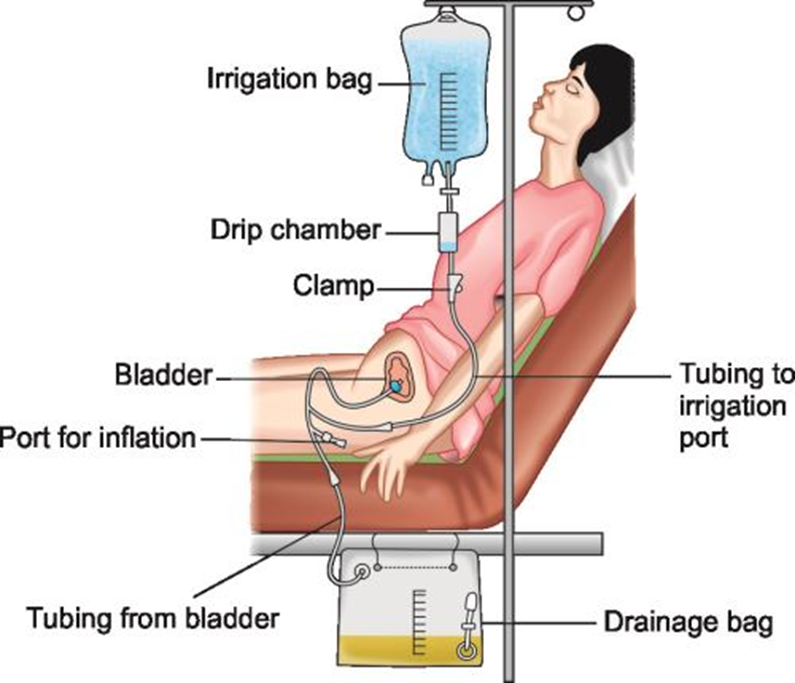A client has an order for continuous bladder irrigation. What should the nurse do with the irrigation solution on the intake and output (I&O) sheet when calculating the fluid balance for this client?
Deduct it from the total urine output.
Subtract it from the intravenous flow sheet as output.
Document the intake hourly in the urine output column.
Add it to the oral intake column.
The Correct Answer is A
Choice A Reason:
When calculating the fluid balance for a client undergoing continuous bladder irrigation (CBI), the irrigation solution must be deducted from the total urine output. This is because the irrigation fluid is not part of the client’s actual urine production but is an additional fluid introduced into the bladder to prevent or remove blood clots and ensure catheter patency. By deducting the irrigation solution from the total urine output, the nurse can accurately determine the client’s true urine output and fluid balance.

Choice B Reason:
Subtracting the irrigation solution from the intravenous flow sheet as output is incorrect. The intravenous flow sheet is used to document fluids administered intravenously, not those introduced into the bladder. Therefore, this choice does not apply to the management of continuous bladder irrigation.
Choice C Reason:
Documenting the intake hourly in the urine output column is also incorrect. The urine output column should reflect the actual urine produced by the client, not the irrigation solution. Including the irrigation solution in this column would lead to an inaccurate representation of the client’s urine output and fluid balance.
Choice D Reason:
Adding the irrigation solution to the oral intake column is incorrect as well. The oral intake column is designated for fluids consumed orally by the client. The irrigation solution is introduced directly into the bladder and should not be recorded as oral intake.
Nursing Test Bank
Naxlex Comprehensive Predictor Exams
Related Questions
Correct Answer is ["1"]
Explanation
We know:
- The prescribed dose is 25 mg.
- The available concentration is 125 mg per 5 mL.
Step 2 is to set up the calculation.
We will use the formula: (Desired Dose in mL) = (Prescribed Dose in mg × Volume Available in mL) ÷ Concentration Available in mg
Step 3 is to plug in the values into the formula.
(Desired Dose in mL) = (25 mg × 5 mL) ÷ 125 mg
Step 4 is to perform the multiplication first.
25 mg × 5 mL = 125
Step 5 is to perform the division.
125 ÷ 125 mg = 1 mL
Step 6 is the result.
The nurse should administer 1 mL per dose.
Correct Answer is D
Explanation
Choice A Reason:
“Records that the client sees the procedure as necessary” is incorrect. The nurse’s role in signing the consent form is not to document the client’s perception of the necessity of the procedure. This responsibility typically falls to the healthcare provider who explains the procedure and its necessity to the client.
Choice B Reason:
“Determines the client does not have a mental illness” is incorrect. While assessing the client’s mental status is part of the overall care, the nurse’s signature on the consent form does not specifically indicate this. The nurse’s role is to witness the client’s signature and ensure they are giving informed consent.
Choice C Reason:
“Assists that the nurse has explained the risks and benefits of the procedure” is incorrect. It is the responsibility of the healthcare provider performing the procedure to explain the risks and benefits. The nurse may reinforce this information but does not primarily provide it.
Choice D Reason:
“Confirms the client is competent to provide consent” is correct. The nurse’s signature on the consent form indicates that the nurse has witnessed the client signing the form and has verified that the client is competent to provide informed consent. This includes ensuring the client understands the information provided and is making the decision voluntarily.
Whether you are a student looking to ace your exams or a practicing nurse seeking to enhance your expertise , our nursing education contents will empower you with the confidence and competence to make a difference in the lives of patients and become a respected leader in the healthcare field.
Visit Naxlex, invest in your future and unlock endless possibilities with our unparalleled nursing education contents today
Report Wrong Answer on the Current Question
Do you disagree with the answer? If yes, what is your expected answer? Explain.
Kindly be descriptive with the issue you are facing.
